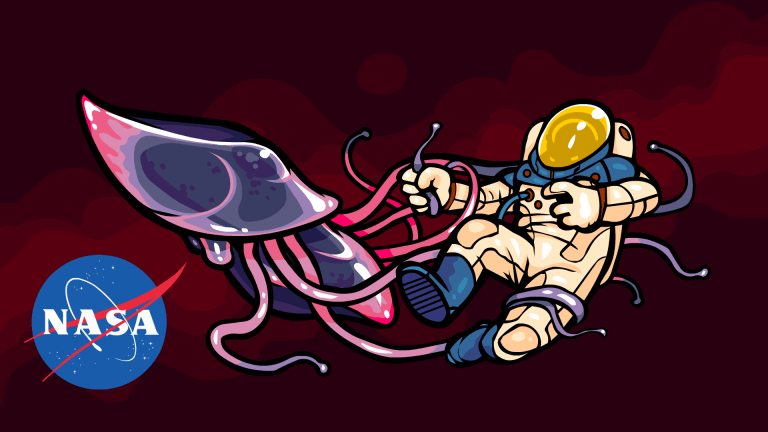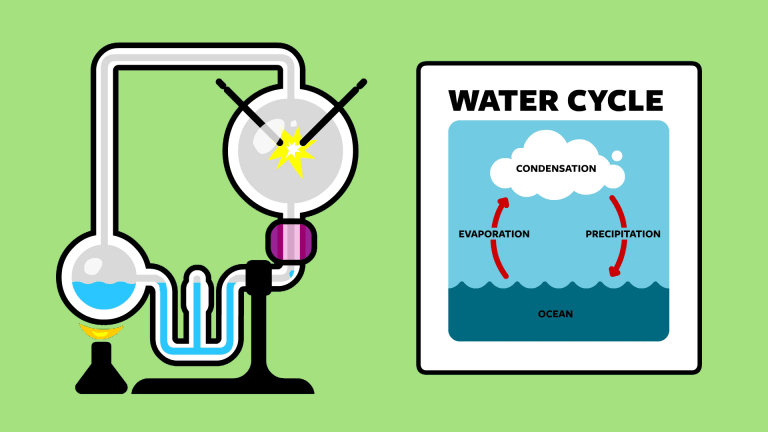Overview
All living creatures today reproduce and evolve using a complex gene-enzyme cycle. If we look at a cell for example, information encoded in its genes is used to produce functional proteins called enzymes. Some of those enzymes then turn around to make copies of the cell’s genes, allowing the cell to reproduce.
Because the gene-enzyme system forms a closed loop, it presents us with a classic chicken or egg conundrum: Which came first, genes or the protein enzymes they code for?
While the details are still not fully worked out, discoveries over the past few decades have lead researchers to a surprising possible solution: What really came first? Genes that act as enzymes!
The RNA World Hypothesis is the idea that before living cells, the genetic code, and the gene/protein cycle ever existed, chains of a chemical called RNA were forming naturally. Once formed, some of these chains were able to function as enzymes, and were even able to evolve by making copies of themselves with slight, accidental modifications.
In the purest form of RNA World Hypothesis, RNA came first and then gave rise to proteins and DNA. This pure form is not largely accepted. It now seems more likely that RNA, DNA, small proto-proteins, and even lipids all coexisted from the start.
While there is little doubt that RNA played a crucial role in the early development of life, the complexity of RNA and DNA nucleotides cast doubt on the idea that RNA was the first truly replicating and evolving chemical system. For this reason, alternatives to the “RNA first” view are being investigated. Most notable is a proto-RNA hypothesis being studied by the lab of Nicholas Hud, and several metabolism first hypotheses which got their start with the work of Robert Shapiro.
At this time all serious investigations into the origin of life are conducted under the overarching idea that life emerged from chemistry.
For Teachers
The content of this video meets criteria in the following Disciplinary Core Ideas defined by Next Generation Science Standards. Use our videos to supplement classroom curriculum.
Contributors
Our videos benefit from guidance and advice provided by experts in science and education. This animation is the result of collaboration between the following scientists, educators, and our team of creatives.
Advisors
- Christopher Parsons, MSc
- David Lynn, PhD
- David O. Conover, PhD
- Eric T. Parker, PhD
- Ram Krishnamurthy, PhD
- Tom Cochran
Team
- Jon Perry
- Jeremiah Deasey
- Anthony Danzl
- Rosemary Mosco
- Jordan Collver
Sources
Ribozymes
The first RNA enzymes were discovered in 1982, now known as ribozymes. Here’s is a wonderful review of what we now know about ribozymes (well… as of 2002):
- Scientific Paper: Ribozymes: Catalytic RNAs that cut things, make things, and do odd and useful jobs
Diverse and highly functional ribozymes can be evolved in the lab. Selection experiments have shown there are many pathways that evolution can take to produce a ribozyme with a given function. This means the evolution of function is much simpler than previously thought! - Scientific Paper: Next-generation sequencing reveals how RNA catalysts evolve from random space
- Nucleotide building ribozymes have been evolved in the lab from random starting chains (this is the experiment discussed in our animation):
- Scientific Paper: Isolation of Fast Purine Nucleotide Synthase Ribozymes
Initial RNA Nucleotide Synthesis
RNA nucleotides are not easy to make but they have been shown to form without enzymes under conditions that might have been plausible on the early Earth. That said, the reactions we’ve discovered so far do not appear robust enough to have initiated the RNA world. A search for a more efficient natural pathway continues.
- Scientific Paper: Synthesis of activated pyrimidine ribonucleotides in prebiotically plausible conditions
- News Article discussing the paper above: Ingenious chemistry shows how nucleotides may have formed in the primordial soup.
RNA Replication Before Evolution Of Enzymes
In order for ribozymes to develop and evolve, they must be able to reproduce. Base pairing allows us to get RNA to easily replicate in the lab but there are several issues impeding replication in natural environments like those that would have existed on the early Earth. Below is a paper outling 8 problems with RNA replication and likely solutions to them (note: number 8 has since been solved by two different research groups independently though one is still waiting to be published:
- Scientific Paper: The eightfold path to non-enzymatic RNA replication
Alternatives To The RNA First Idea
RNA certainly played an important early role in life but the difficulties of producing RNA under pre-biotic conditions raises doubts about RNA chains truely being the first replicators.
- Article contrasting several ideas about life origins, including the metabolism first hypothesis: by professor Laurance Moran: Metabolism First and the Origin of Life
- Media article reviewing research into a possible proto RNA World Hypothesis: Chemists Seek Possible Precursor to RNA
Transcript
If you were to go back in time 120 million years, you’d find yourself in a Dinosaur World, 500 million years ago was a world of trilobites and other strange sea creatures, 3.4 billion years ago was the world of the first living cells, and if you were to go back further still, scientists suspect that chains of a chemical called RNA, or something similar to RNA, kickstarted this entire beautiful mess that we call life.
RNA is thought to have given rise to life for several reason: chains of RNA are found abundantly in all living cells today, RNA is a close chemical cousins to DNA, and with very little help from researchers, RNA chains can replicate, evolve, and interact with their environments.
While many details have yet to be worked out, the RNA world hypothesis is the simple idea that somewhere on our early planet, perhaps in a tide pool or hot spring, the Earth’s chemistry was producing random chains of RNA. Once formed, they began replicating, evolving, and competing with each other for survival.
As these chains evolved and diversified, some eventually began cooperating to produce the genetic code, a wide array of complex proteins, and even living cells which from the perspective of RNA can actually be thought of as houses or “survival machines” for RNA to live inside.
To understand how RNA chains can interact with their environments, replicate, and evolve; we first need to understand the simple process of base pairing.
Chains of RNA are made of nucleotides — small molecules that come in 4 different types labeled A,C,U and G.
The backbone atoms of a nucleotide (shown here as a yellow bar) can form strong chemical bonds with the backbone atoms of any other RNA nucleotide. This means that different chains can have completely different sequences from left to right.
The parts we call the bases of nucleotides (the colored sections labeled A, C, U, or G) are attracted to other bases, sort of like a magnet, but they’re selective about who they will stick to: G selectively pairs with C, A selectively pairs with U.
When bases find their matches and stick together, we call it base pairing. Researchers have found that with a little bit of assistance, base pairing allows chains of RNA to replicate and evolve. Here’s how it works:
When a long chain of RNA is suspended in cool water with high concentrations of free nucleotides, the chain can act as a template for its own replication. Nucleotides automatically base pair with their partners on the existing chain. If their backbone atoms form chemical bonds with each other (by the way, this is the part that currently requires assistance from researchers, we’re not yet sure how this would have happened in the wild) a complementary RNA strand is born—one with the exact inverse sequence of the original. If the water is then heated, paired bases lose their grip, allowing both chains to act as templates when the cycle repeats.
The great thing about this process is that every other RNA chain produced, is a copy of the original but sometimes mutations slip in. This means that as chains compete for survival and reproduction, true evolution – descent with modification, acted upon by selection – can operate on chains of RNA.
As amazing as replication is, base pairing also gives RNA chains a second special ability.
When placed in water cool enough for base pairing but without enough free nucleotides for replication, chains will fold up and base pair with themselves. The end result is a complex shape with certain sticky bases pointing outward because they weren’t able to find partners. These sticky outward facing bases can cause unique chemical reactions, by interacting with other molecules in their environment.
A folded chain of RNA capable of guiding a specific chemical reaction is what we call a ribozyme. Some ribozymes break certain molecules apart, others join certain molecules together. A ribozyme’s specific function is determined by its specific shape, and its shape is determined by its sequence. If a mutation changes a ribozyme’s sequence, the shape can be modified and so can its function.
When ribozymes were first discovered scientists wondered how difficult it would be for random chains of RNA to evolve legitimate survival functions. Imagine, for example, a ribozyme that could build nucleotides out of molecules it finds in its environment. Across multiple generations, natural selection could promote and refine this ribozyme because the chain would tend to have access to more free nucleotides than its rivals, allowing it to replicate more often.
To explore this idea, researchers at Simon Fraser University produced a large group of random RNA chains, and examined them to see if any happened to be able to make nucleotides. Surprisingly, some actually could, but they weren’t very efficient.
Researchers selected out the successful chains and then used a lab technique called PCR to quickly replicate them with slight random mutations. After just 10 rounds of PCR followed by selection, highly efficient nucleotide building ribozymes evolved — these are molecules with the life-like ability to actively participate in their own survival!
These ribozymes, and many others produced through similar experiments, are beginning to blur the line between living things and simple chemistry.
So to sum things up, the RNA world hypothesis is the simple idea that the first things to replicate and evolve on our planet may have been chains of RNA, or something similar to them.
While the basic idea of the RNA world does seem to give us a promising pathway to the origin of life, it’s still very much a work in progress. As mentioned, one of several unsolved problems is how did nature get backbone binding to function without the special enzymes or the lab techniques we use today?
While many researchers continue to focus on RNA, others are investigating alternative molecules — chemical systems that might replicate and evolve without assistance, and could have given rise to RNA. Continual breakthroughs are being found in both avenues of research.





